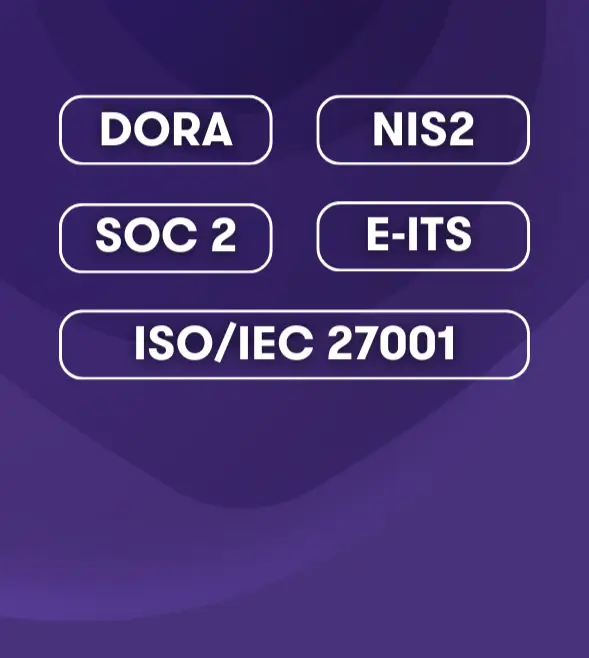-
Other audit services
We help clients with the application and use of foreign financial aid of EU and other funds and help prepare financial reports.
-
Audit calculator
The calculator will answer if the company's sales revenue, assets or number of employees exceed the limit of an inspection or audit.
-
Payroll and related services
We perform payroll accounting for companies whether they employ a few or hundreds of employees.
-
Tax accounting
Grant Thornton Baltic's experienced tax specialists support accountants and offer reasonable and practical solutions.
-
Reporting
We prepare annual reports in a timely manner. We help to prepare management reports and various mandatory reports.
-
Consolidation of financial statements
Our experienced accountants and advisors help you prepare consolidation tables and make the consolidation process more efficient.
-
Consultancy and temporary staff
Our experienced specialists advise on more complex accounting transactions, rectify poor historic accounting, and offer the temporary replacement of an accountant.
-
Outsourced CFO service
Our CFO service is suitable for companies of all sizes and in all industries. We offer services to our clients in the required amount and competences.
-
Assessment of accounting processes
We help companies to implement accounting practices that are in compliance with local and international standards.
-
Accounting services for small businesses
We offer affordable service for small businesses. We help organize processes as smartly and cost-effectively as possible.
-
Cryptocurrency accounting
We keep up with blockchain technology to serve and advise crypto companies. We are supported by a network of colleagues in 130 countries.
-
Trainings and seminars
Our accountants have experience in all matters related to accounting and reporting. We offer our clients professional training according to their needs.

-
Business advisory
We offer legal support to both start-ups and expanding companies, making sure that all legal steps are well thought out in detail.
-
Fintech advisory
Our specialists advise payment institutions, virtual currency service providers and financial institutions.
-
Corporate advisory
We advise on legal, tax and financial matters necessary for better management of the company's legal or organizational structure.
-
Transaction advisory
We provide advice in all aspects of the transaction process.
-
Legal due diligence
We thoroughly analyze the internal documents, legal relations, and business compliance of the company to be merged or acquired.
-
In-house lawyer service
The service is intended for entrepreneurs who are looking for a reliable partner to solve the company's day-to-day legal issues.
-
The contact person service
We offer a contact person service to Estonian companies with a board located abroad.
-
Training
We organize both public trainings and tailor made trainings ordered by clients on current legal and tax issues.
-
Whistleblower channel
At Grant Thornton Baltic, we believe that a well-designed and effective reporting channel is an efficient way of achieving trustworthiness.

-
Business model or strategy renewal
In order to be successful, every company, regardless of the size of the organization, must have a clear strategy, ie know where the whole team is heading.
-
Marketing and brand strategy; creation and updating of the client management system
We support you in updating your marketing and brand strategy and customer management system, so that you can adapt in this time of rapid changes.
-
Coaching and development support
A good organizational culture is like a trump card for a company. We guide you how to collect trump cards!
-
Digital services
Today, the question is not whether to digitize, but how to do it. We help you develop and implement smart digital solutions.
-
Sales organisation development
Our mission is to improve our customers' business results by choosing the right focuses and providing a clear and systematic path to a solution.
-
Business plan development
A good business plan is a guide and management tool for an entrepreneur, a source of information for financial institutions and potential investors to make financial decisions.
-
Due diligence
We perform due diligence so that investors can get a thorough overview of the company before the planned purchase transaction.
-
Mergers and acquisitions
We provide advice in all aspects of the transaction process.
-
Valuation services
We estimate the company's market value, asset value and other asset groups based on internationally accepted methodology.
-
Forensic expert services
Our experienced, nationally recognized forensic experts provide assessments in the economic and financial field.
-
Business plans and financial forecasts
The lack of planning and control of cash resources is the reason often given for the failure of many businesses. We help you prepare proper forecasts to reduce business risks.
-
Outsourced CFO service
Our CFO service is suitable for companies of all sizes and in all industries. We offer services to our clients in the required amount and competences.
-
Reorganization
Our experienced reorganizers offer ways to overcome the company's economic difficulties and restore liquidity in order to manage sustainably in the future.
-
Restructuring and reorganisation
We offer individual complete solutions for reorganizing the structure of companies.
-
Corporate taxation
We advise on all matters related to corporate taxation.
-
Value added tax and other indirect taxes
We have extensive knowledge in the field of VAT, excise duties and customs, both on the national and international level.
-
International taxation
We advise on foreign tax systems and international tax regulations, including the requirements of cross-border reporting.
-
Transfer pricing
We help plan and document all aspects of a company's transfer pricing strategy.
-
Taxation of transactions
We plan the tax consequences of a company's acquisition, transfer, refinancing, restructuring, and listing of bonds or shares.
-
Taxation of employees in cross-border operations
An employee of an Estonian company abroad and an employee of a foreign company in Estonia - we advise on tax rules.
-
Tax risk audit
We perform a risk audit that helps diagnose and limit tax risks and optimize tax obligations.
-
Representing the client in Tax Board
We prevent tax problems and ensure smooth communication with the Tax and Customs Board.
-
Taxation of private individuals
We advise individuals on personal income taxation issues and, represent the client in communication with the Tax and Customs Board.
-
Pan-Baltic tax system comparison
Our tax specialists have prepared a comparison of the tax systems of the Baltic countries regarding the taxation of companies and individuals.
-
Internal audit
We assist you in performing the internal audit function, performing internal audits and advisory work, evaluating governance, and conducting training.
-
Internal Audit in the Financial Services Sector
We provide internal audit services to financial sector companies. We can support the creation of an internal audit function already when applying for a sectoral activity license.
-
Audit of projects
We conduct audits of projects that have received European Union funds, state aid, foreign aid, or other grants.
-
Prevention of money laundering
We help to prepare a money laundering risk assessment and efficient anti-money laundering procedures, conduct internal audits and training.
-
Risk assessment and risk management
We advise you on conducting a risk assessment and setting up a risk management system.
-
Custom tasks
At the request of the client, we perform audits, inspections and analyzes with a specific purpose and scope.
-
External Quality Assessment of the Internal Audit Activity
We conduct an external evaluation of the quality of the internal audit or provide independent assurance on the self-assessment.
-
Whistleblowing and reporting misconduct
We can help build the whistleblowing system, from implementation, internal repairs and staff training to the creation of a reporting channel and case management.
-
Information security management
We provide you with an information security management service that will optimise resources, give you an overview of the security situation and ensure compliance with the legislation and standards.
-
Information security roadmap
We analyse your organisation to understand which standards or regulations apply to your activities, identify any gaps and make proposals to fix them.
-
Internal audit of information security
Our specialists help detect and correct information security deficiencies by verifying an organization's compliance with legislation and standards.
-
Third party management
Our specialists help reduce the risks associated with using services provided by third parties.
-
Information security training
We offer various training and awareness building programmes to ensure that all parties are well aware of the information security requirements, their responsibilities when choosing a service provider and their potential risks.
-
Digital Operational Resilience Act (DORA)
We will help you create a DORA implementation model that meets your company's needs and ensures that you meet the January 2025 deadline.

-
ESG advisory
We help solve issues related to the environment, social capital, employees, business model and good management practices.
-
ESG audit
Our auditors review and certify sustainability reports in line with international standards.
-
Sustainable investments
We help investors conduct analysis of companies they’re interested in, examining environmental topics, corporate social responsibility and good governance practices.
-
Sustainable tax behaviour
Our international taxation specialists define the concept of sustainable tax behaviour and offer services for sustainable tax practices.
-
ESG manager service
Your company doesn’t necessarily need an in-house ESG manager. This role can also be outsourced as a service.

-
Recruitment services – personnel search
We help fill positions in your company with competent and dedicated employees who help realize the company's strategic goals.
-
Recruitment support services
Support services help to determine whether the candidates match the company's expectations. The most used support services are candidate testing and evaluation.
-
Implementation of human resource management processes
We either assume a full control of the launch of processes related to HR management, or we are a supportive advisory partner for the HR manager.
-
Audit of HR management processes
We map the HR management processes and provide an overview of how to assess the health of the organization from the HR management perspective.
-
HR Documentation and Operating Model Advisory Services work
We support companies in setting up HR documentation and operational processes with a necessary quality.
-
Employee Surveys
We help to carry out goal-oriented and high-quality employee surveys. We analyse the results, make reports, and draw conclusions.
-
HR Management outsourcing
We offer both temporary and permanent/long-term HR manager services to companies.

-
Digital strategy
We help assess the digital maturity of your organization, create a strategy that matches your needs and capabilities, and develop key metrics.
-
Intelligent automation
We aid you in determining your business’ needs and opportunities, as well as model the business processes to provide the best user experience and efficiency.
-
Business Intelligence
Our team of experienced business analysts will help you get a grip on your data by mapping and structuring all the data available.
-
Cybersecurity
A proactive cyber strategy delivers you peace of mind, allowing you to focus on realising your company’s growth potential.
-
Innovation as a Service
On average, one in four projects fails and one in two needs changes. We help manage the innovation of your company's digital solutions!

Author: Kristiine Villemi
An annual audit is an indispensable resource for obtaining assurance that a company’s financial statements and accounting is free from material misstatements. One of the most important preconditions for productive cooperation between auditor and the company is adherence to deadlines and being ready for the audit at the agreed time.
The auditor verifies the accuracy of the financial information and the functioning of the company’s processes. At the end of the audit, the auditor gives the client feedback on audit findings and deficiencies in internal control and recommendations for eliminating them to protect the company against fraud and misstatements.
Good preparation is half the battle
Before the audit begins, the auditor sends the client a list of documents that the client can start getting ready or sending to the auditor in advance. If all of the documents requested are submitted to the auditor by the agreed time, there is high confidence that the audit will be completed much faster than if the client starts sending documents only once the auditor is present. It’s even worse if it’s something that is thought about only after the auditor arrives.
In the last case, the auditor will expend much time on the spot waiting for documents and it is very likely the auditor will not get all of the documents. That means that the auditor must come back again or two or three times, which in turn prolongs the audit.
Documents must be accurate
It is worth knowing that it isn’t enough to just assemble a stack of documents if they are not accurate and in line with accounting records. In such a case, the auditor will spend much more time checking the documents. In accordance with subsection 15 (3) of the Accounting Act, for the purposes of preparing annual accounts, inventory shall be taken of all balances of the assets and liabilities of the accounting entity, meaning that the conformity of the balances to the main accounting principles set forth in Section 16 of the Accounting Act should be assessed. All balances in the balance sheet and income statement must be inventoried. The accountant must know exactly which amounts they consist of and be capable of providing source documents to the auditor.
Physical inventory means counting or checking something
The actual results revealed by the stock-taking or physical inventory must be compared to accounting information, and if there are discrepancies the reasons must be determined and corrections made. For example, the physical inventory of cash in hand, stocks and non-current assets balances must be performed by counting and the results documented in the inventory report.
In case of inventories, it is also important to indicate the inventory balances whose book value has decreased below the net realizable value. This impairment should be recognized in accounts. If the auditor believes that the inventory balance is significant from the standpoint of the annual financial statements, the auditor shall participate in the stock-taking as an observer and perform spot checks.
In the case of non-current assets, non-current assets unfit for use must be written off. The adequacy of depreciation rates must also be reviewed.
With regard to bank balances, the auditor requests the client to ask the bank for a letter of confirmation where besides the cash and investment balances, the bank also brings out all of the company’s obligations, including collaterals and guarantees. As to the balance of receivables recognized in the balance sheet, the accountant must know what receivables it consists of. The collectability of receivables must also be estimated, and if necessary, an allowance for doubtful accounts formed. Confirmation of balances must be obtained from the counterparties as well. If the company has issued loans, the borrower’s solvency and collectability of the loans must be evaluated. It is not enough for the other party to just confirm the balance, as this does not give the auditor assurance regarding the value of the receivable.
Taking inventory of prepaid expenses should not be neglected, because it should be checked that all expenses for the audited period are recognized in the income statement. On the liabilities side, payables to suppliers and loans received must be inventoried. Balance confirmations are sent out to make sure that there are no obligations that are not recognized (such as accrual-basis interest). In the case of tax balances, the tax balances in the accounting software should be compared with the balances reported to the tax authority. Among others, late fees and interest must also be taken into consideration.
Nor should the inventorying of payables to employees, including holiday obligations, be neglected. If the company has liabilities where the date and amount of realisation are not certain, the provision must be recognized in the balance sheet (e.g. warranty reserve) and the auditor must receive a documented evaluation from the management on how this representation was arrived at.
In the case of the income statement, the auditor must obtain evidence that all transactions are recognized correctly and pursuant to the source documents and that no transactions have failed to be recognized. In accounting, the matching principle of revenues and expenses must be followed. If accounts have been kept correctly, there will be no need to prepare anything, because as subsection 6 (4) of the Accounting Act states, all accounting entries shall be supported by source documents certifying the corresponding business transactions or by summary documents prepared on the basis of source documents. If all source documents exist, all that is left to do is get ready the documents the auditor has requested.
We certainly advise devoting more attention to the transactions that preceded and followed the year’s end, so that all items are recognized in the right period. With regard to unrecognized transactions, keeping the lines open between the management and accounting department is important as often there are situations where a transaction has not been recognized precisely because the documents did not reach the accountant in a timely manner. Thus, good cooperation and exchange of information between the company’s executives and the accountant should not be underestimated as a requirement for a smooth audit process.
Constant communication with auditor
Yet another important factor that some audits go more efficiently than others is an open communication style. The most ideal client for an auditor is an accountant who constantly consults the auditor if there is a question about some transaction. Resolving problems straight away is much more effective than correcting mistakes discovered during an audit. The latter is one of the main reasons that the final deadlines tend to be overrun.
An interim audit can be a help
Conducting an interim audit is something that should definitely be supported. An interim audit means that, e.g. if your financial year ends at 31 December, the auditor may carry out some procedures based on 9-month reports in October so that the final audit at year’s end goes smoother and faster. In the course of the interim report, both past events and future plans affecting reporting during the period are discussed. In addition, key areas and the audit plan are agreed. Transactions that have taken place to that point can also be reviewed. If the interim audit has been performed effectively, the only thing left to check in the final audit is the transactions and balances for the last three months.
Auditing the annual report is time-consuming
The time expended on auditing the annual report cannot be underestimated, as this may often mean more time outlay for the auditor than originally expected. This can happen if hastily and carelessly prepared financial statements are presented to the auditor, followed by the auditor preparing a long list of audit findings of which the accountant decides to correct only half. Once the auditor has checked the statements, the auditor must indicate the same findings again and sometimes new errors have cropped up in addition to the errors that were left uncorrected.
Nor is it unusual for the report to be bounced back and forth four or five times. It is obvious that such an audit will not be successful. Thus, we advise taking time to prepare the financial statements, reviewing the findings made the last year and taking them into consideration in preparing the report for the year at hand.
The principal errors are lack of notes explaining key balances, the lack or incorrectness of references and cross-references (in all of the main financial statements), leaving key circumstances unaccounted for (such as events following the balance sheet date), conflict between accounting policies and the company’s accounting itself, incorrect cash flow statement, and failure to recognize related-party transactions and balances.
A separate document folder simplifies work
To find documents faster during the audit, some accountants prepare a separate audit folder, which is a good idea and simplifies all of the parties’ work. Many times, we have heard opinions that the accountant does not wish to present the draft annual report to the auditor by the start of the audit, as “it will have to be changed anyway.” Actually it is good practice for the preliminary annual report to be included in the documents presented to the auditor. The accountant should not be preparing the annual report knowing that something is definitely incorrect, because pursuant to the Accounting Act, they have to be sure that all balances are correct before the annual report is prepared. The presentation of the draft annual report by the start of the audit is a signal that the accountant is ready for the audit.
Ten recommendations for a successful audit
- Timely selection of auditor and realistic schedule.
- Sticking to deadlines and honouring agreements, including timely submission of documents to auditor pursuant to the list received in advance.
- Performing a preliminary audit to spread out workload and detect possible errors early.
- Accounts are inventoried timely and source documents for all transactions exist and can easily be retrieved.
- Conformity of accounting policies and procedures to actual situation, annual review and updating, if necessary.
- Regular communication with auditors and, in the case of complicated transactions, consulting them in advance.
- Efficient exchange of information between financial department and management. Management must be included in making estimates.
- A working internal control system laid down based on the company’s profile and needs.
- Positive attitude toward auditors.
- Correctly and timely prepared annual report.
If you had any questions about this topic while reading this article, please contact our audit department on 626 0500 or e-mail audit@ee.gt.com.








